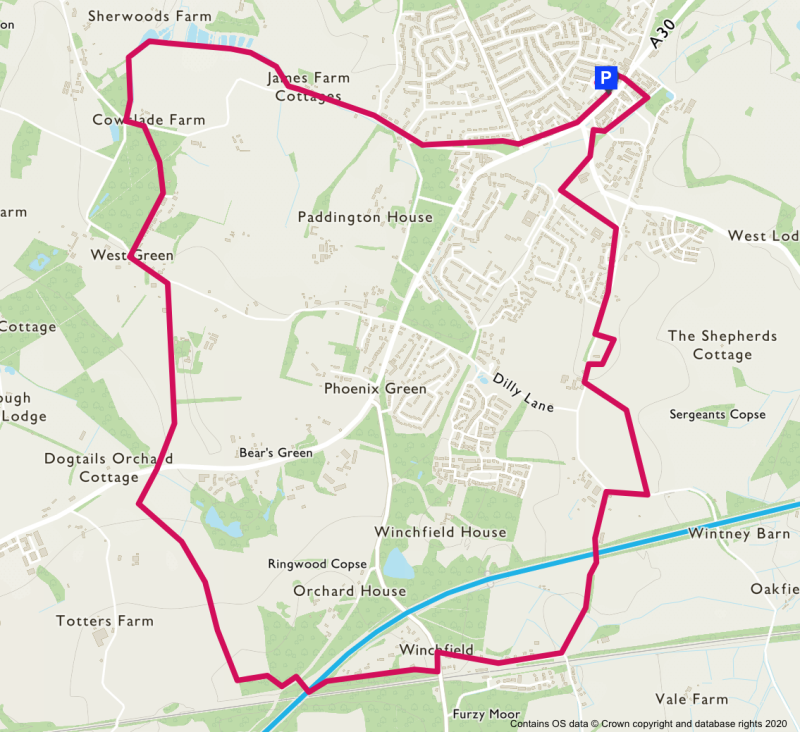Hartley Wintney Countryside
Wonderful trees, farmland, wildflowers and birds
Walk west along the High Street to the village pond. In winter this has had a few ducks but in the summer of 2020 it was very overgrown but overlooked by a beautiful willow tree. Take the path to the left of the pond and tree towards the Fleet Road and cross at the lights. Carry on to the right of St John's Church and the war memorial.
Turn left immediately after St John's and up the slope to Church Lane. Enjoy the sturdy 'Mildmay' or 'Trafalgar' oaks here, some said to have been planted as acorns in the eighteenth century.
On reaching Church Lane at the top, turn right and continue on path and road to St Mary's Church. Visit the burial ground at the first gate on the left, turn right at the first path and see the seats placed to enjoy the tranquility and countryside views. In this beautiful churchyard is buried Alan Francis Brooke, 1st Viscount Alanbrooke of WWII fame. He loved birds and found relief from wartime by watching and hearing them.
Go around the church and exit to a footpath via a small gate on the left after the toilet, or leave by the Lych Gate and turn left and left again onto the path inside the woodland. This drops to the road where you turn back slightly to climb the stile enter the field and turn down the obvious path through daisies and crops in summer.
At the bottom, cross over to the path opposite and head up the slope and down into the Taplin's Lane beyond. On the way you may notice different birds such as seed loving Yellowhammers singing and plenty of wildflowers, crickets and butterflies.
Turn right into Taplin's Lane. The next path is to the left immediately after South Cottage but it's worth going a few yards further to join the track if the path is overgrown. Follow this track past a gate, down towards and over the motorway. I found wildflowers everywhere here and a field full of bright yellow ragwort.
The path goes left of the gate at the end of the concrete through a planted hedgerow of native trees now growing well. Keep going to the end and avoid the farm track as you angle right staying on the footpath past some good, nature friendly fallow land. I found many wildflowers and butterflies here.
Next you meet the road, turning right and soon passing Winchfield Station on the left then turning left at the T junction and very soon right onto a narrow footpath immediately before a red brick wall by the railway bridge. This is not specially attractive as a path but had some beautiful wild honeysuckle and many singing Goldcrests to brighten the journey. The path drops gloomily beneath the motorway and rises steeply up the steps again before turning left.
This is the 'Brenda Parker Way' and we turn right and you follow this for a while soon entering a path lined by grand hedgerow trees. There are many big, old ash trees here mixed with the oaks, no sign of dieback as I passed. You also pass an old WWII pillbox. Enjoy this lovely hedgerow and seek a path to the right across a small footbridge and into a fallow field rich in flowers and butterflies and crickets. Cross this on the path to the A30.
Cross the A30 carefully heading to the left of the right hand gate. You are still on the Brenda Parker Way. Cross the stiles and head up on the right side of the field where you may find cattle grazing in the meadows. Again there are lovely old oaks lining the field and one or two good specimens in the field itself. See the big house in front of you and climb the stile onto a rather narrow path with trip hazards. At the end, over the stile, join the lane turn left then take the next road to your right.
This is West Green Common, an important woodland for Oak and Hornbeam, a tree recognised by its smooth but strangely twisted bark. Follow the road or step up onto the grass and where the road and rough track ends follow the path past the old building hidden in the woods keeping in the same direction, crossing over a central track until you emerge on the road where you turn left. (In the woodland you will pass patches of coppiced Hazel. good for ground flora and insect life. Management of this area caused a 25% increase in flora).
At the road junction follow the gravel/tarmac drive to the right and continue until you reach somebody's large back garden! The path turns right past some ponds with wildfowl and rich bird habitat and then goes right via a footbridge over a ditch and to the left after the hedgerow in front of you. Sloes, water mint and other wild plants grow along this path. Cross the lane taking the gate to the right and reach the road where you turn left.
This leads you back to Hartley Wintney with a final chance to walk under big oaks on the path to the left on the way to the main road junction. Cross over at the foot of Bracknell Lane and follow the road back to the village.



